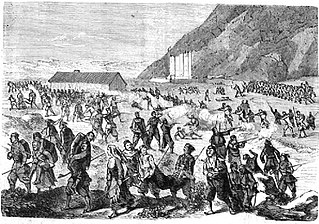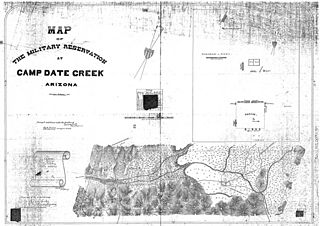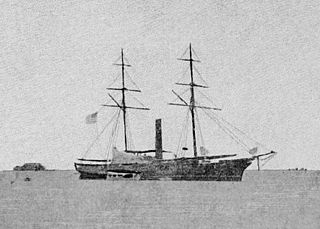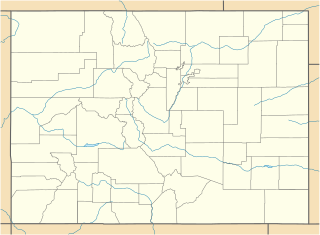 W
WThe Krivošije uprising of 1869 was an internal conflict in the far south of the Austro-Hungarian Empire that broke out following the Austro-Hungarian government's decision to extend military conscription to the tribe and region of Krivošije. It lasted from October 1869 until a formal peace accord was signed on 11 January 1870. The rebels managed to defeat the Austro-Hungarian army detachments sent against them and in the end the government conceded on all points of dispute.
 W
WThe Battle of Acosta Ñu or Campo Grande was a battle during the Paraguayan War, fought on August 16, 1869, between the Triple Alliance and Paraguay. The 3,500 poorly armed Paraguayans, mostly boys between nine and 15 years old, old men and wounded combatants, confronted 20,000 Brazilian veteran soldiers.
 W
WThe Campaign of the Hills was the last campaign of the Paraguayan War, lasting from July 1869 to the end of the war on March 1, 1870. The Paraguayans were completely defeated by the Allies. Brazilian writer Alfredo d'Escragnolle Taunay, Viscount of Taunay took part in the campaign and later wrote about it. At least 5,000 Paraguayans were killed during this campaign.
 W
WThe Cretan revolt of 1866–1869 or Great Cretan Revolution was a three-year uprising in Crete against Ottoman rule, the third and largest in a series of Cretan revolts between the end of the Greek War of Independence in 1830 and the establishment of the independent Cretan State in 1898.
 W
WThe Battle of Hakodate was fought in Japan from December 4, 1868 to June 27, 1869, between the remnants of the Tokugawa shogunate army, consolidated into the armed forces of the rebel Ezo Republic, and the armies of the newly formed Imperial government. It was the last stage of the Boshin War, and occurred around Hakodate in the northern Japanese island of Hokkaidō. In Japanese, it is also known as the Battle of Goryokaku
 W
WThe Naval Battle of Hakodate was fought from 4 to 10 May 1869, between the remnants of the Tokugawa shogunate navy, consolidated into the armed forces of the rebel Ezo Republic, and the newly formed Imperial Japanese Navy. It was one of the last stages of Battle of Hakodate during the Boshin War, and occurred near Hakodate in the northern Japanese island of Hokkaidō.
 W
WThe Hualapai War, or Walapai War, was an armed conflict fought from 1865 to 1870 between the Hualapai native Americans and the United States in Arizona Territory. The Yavapai also participated on the side of the Hualapai and Mohave scouts were employed by the United States Army. Following the death of the prominent Yavapai leader Anasa in April 1865, the natives began raiding American settlements which provoked a response by the United States Army forces stationed in the area. By the spring of 1869 disease forced the majority of the Hualapais to surrender though some skirmishing continued for almost two more years.
 W
WThe Kake War was the destruction in February 1869 of three semi-permanent winter villages and two forts near present-day Kake, Alaska by the USS Saginaw. Prior to the conflict, two white trappers were killed by the Kake in retribution for the death of two Kake departing Sitka village by canoe. Sitka was the site of a standoff between the Army and Tlingit due to the army demanding the surrender of chief Colchika who was involved in an altercation in Fort Sitka.
 W
WThe Klang War or Selangor Civil War was a series of conflicts that lasted from 1867 to 1874 in the Malay state of Selangor. It was initially fought between Raja Abdullah bin Raja Jaafar, the administrator of Klang, and Raja Mahadi bin Raja Sulaiman. It was joined by Tengku Kudin, as well as Malay and Chinese rival factions. The war was eventually won by Tengku Kudin and Abdullah's son, Raja Ismail.
 W
WThe Battle of Miyako Bay was a naval action on 6 May 1869. It was part of the overall Battle of Hakodate at the end of the Boshin War, a civil war in Japan between Imperial forces of the new Meiji government, and samurai loyalists to the former Tokugawa shogunate under the flag of the newly formed Republic of Ezo.
 W
WOpepe was a settlement in New Zealand, a few miles southwest of Taupo. It was the scene of an attack between European militia and Maori on 7 June 1869 in which nine members of the militia were killed.
 W
WThe Battle of Piribebuy was fought on August 12, 1869 in the Paraguayan town of Piribebuy, which was then serving as a temporary capital of the Paraguayan government. The Paraguayan defenders, who were poorly armed and included children, fought the attacks of the Allied forces, led by French-born Brazilian general Prince Gaston, son-in-law of Emperor Pedro II of Brazil. The town refused two peace envoys, calling for surrender, sent by the Conde d'Eu. At 0400, the Brazilian batteries surrounding the town started a bombardment which lasted until 0800, when the infantry charged. Gen. João Manuel Mena Barreto was mortally wounded leading a cavalry charge.
 W
WThe Sacking of Asunción was the occupation of the Paraguyan capital carried out as of January 1, 1869 by Brazilian forces in the Triple Alliance led by General João de Souza da Fonseca Costa. Asunción was deserted, evacuated by all its inhabitants two days before. On January 5 Caxias entered the city with the rest of the army. Most of Caxias army settled in Asunción, where also 4000 Argentinian and 200 Uruguayan troops soon arrived together with about 800 soldiers and officers of the Paraguayan Legion. By this time Caxias was ill and tired. On January 17 he fainted during a mass, relinquished his command on 18th and left for Montevideo on 19th.
 W
WThe Battle of Summit Springs, on July 11, 1869, was an armed conflict between elements of the United States Army under the command of Colonel Eugene A. Carr and a group of Cheyenne Dog Soldiers led by Tall Bull, who was killed during the engagement. The US forces were assigned to retaliate for a series of raids in north-central Kansas by Chief Tall Bull's Dog Soldiers band of the Cheyenne. The battle happened south of Sterling, Colorado in Washington County near the Logan/Washington county line.
 W
WTītokowaru's War was a military conflict that took place in the South Taranaki region of New Zealand's North Island from June 1868 to March 1869 between the Ngāti Ruanui and Ngāruahine Māori tribes and the New Zealand Government. The conflict, near the conclusion of the New Zealand wars, was a revival of hostilities of the Second Taranaki War as Riwha Tītokowaru, chief of Ngaruahine, responded to the continued surveying and settlement of confiscated land with well-planned and effective attacks on settlers and government troops in an effort to block the occupation of Māori land.
 W
WThe Wrangell Bombardment was the bombardment of the Stikine village of Old Wrangell by the United States Army in 1869. The army issued an ultimatum to the villagers, demanding they deliver a Stikine named Scutd-doo to justice following the retribution murder of Leon Smith by Scutd-doo. Scutd-doo's son, Lowan, had earlier been killed by soldiers following an altercation in which he bit off a finger of the wife of the quartermaster of Fort Wrangell.